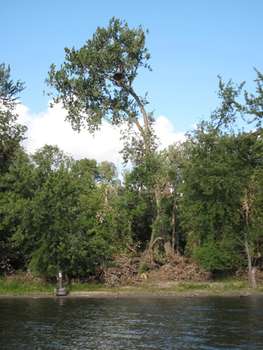MAC acts to evict prolific St. Paul eagle family

The eagles nest in question now stands alone and exposed after the MAC removed the older mature surrounding trees.
(Photo: Steve Johnson)
A key nest of eagles in St. Paul may not have technically been evicted, but the landlord has effectively turned off the heat, and left their home open and exposed to the elements.
For years, an eagles nest in a mature stand of cottonwood trees on Pigs Eye Island has been among the most fertile eagle breeding grounds on the Mississippi. But that may come to a rapid end, after the Metropolitan Airports Commission (MAC) removed every major tree around the nest, leaving their nest exposed and unprotected.
Under the Bald and Golden Eagle Protection Act, it is illegal to remove an active eagles nest. If the actions in question result in the abandonment of this eagles nest, that may also constitute an illegal conflict with the Act.
The nesting site is on an island owned by the Met Council, and located adjacent to the Twin Cities wastewater treatment plant. The Met Council permitted the removal of the long-standing cottonwood trees at the request of the Metropolitan Airports Commission (MAC).
As longtime river steward Steve Johnson notes in his personal blog, MAC has long sought to reduce the number of birds in the vicinity of airport. On the one hand, the MAC has some reasonable expectations of safety - an eagle that was sucked into an airplane engine earlier this year shows a potential for conflict.
But it seems unreasonable to expect to substantially eliminate birds from the immediate area. The Mississippi River valley is the central migratory spine through central North America. Much of the surrounding land is dedicated to a state Scientific and Natural Area and Nature Sanctuary.
The MACs recent draft zoning regulations for the Holman Field Airport contemplates prohibiting any natural features that would prove attractive to birds. Depending on interpretation, the river itself could be understood as an attractor for birds, and be prohibited under this overly-broad definition.
The MACs prior efforts at relocation including the use of fireworks to get the birds to move from their nest, and the relocations of birds to northern Minnesota have not worked. The birds keep returning to the nest, year after year. But the MACs approach in this case raises serious legal questions.
The net effect of the removal may be to cause the birds left in the net to move to another nest, due to increased exposure to the elements. Thats deeply unfortunate because the nest was among the most productive on the Mississippi. Because the tree removal seems intended to undermine the viability of the nest, the removal may have been not just been inadvisable, but illegal.
FMR will update the issue with any future updates in future editions of Mississippi Messages.